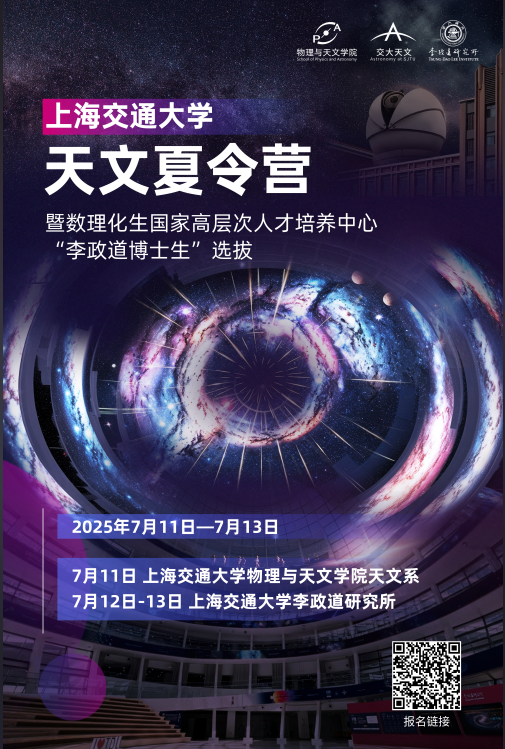
上海交通大学天文学科将于2025年7月11日-13日联合举办2026级研究生招生夏令营。在本次活动中,还将开展国家数理化生高层次人才培养中心“李政道博士生”的选拔,入选学生将享受更多政策优惠和助研津贴,在生活、学业、研究及国际交流等各方面获得丰富资助。
我们诚邀全国各大高校热爱天文、成绩优异、具备科研潜力的大三学生报名参与,共同探索宇宙奥秘,开启璀璨学术生涯的新篇章!
01 学科简介
数理化、天地生。作为六大基础学科之一,天文学一直引领人类探索着自然科学的边疆。近年来,天文学发展迅速,暗物质、暗能量、引力波、系外行星、高红移星系、极端天体等重大发现纷至沓来,已经多次获得诺贝尔物理奖的青睐。2013年国务院《国家重大科技基础设施建设中长期规划》明确将天文列为重点发展领域,但是我国天文人才非常短缺,急需一流天文单位的培养与支撑。
天文学是国家一级学科,也是上海交通大学“双一流”建设学科。上海交通大学天文学科在2016年教育部排名第四,并于2017年在物理与天文学院正式成立天文系。在此期间,李政道研究所于2016年11月在上海交通大学成立。天文与天体物理研究部(天文部)是李政道研究所三大研究部之一。天文系和天文部优势互补,合作密切,共同构成上海交通大学天文学科。学科排名稳步上升,在2020年软科排名第三,2022年入选国家一流天文专业建设点,2021-2023年泰晤士高等教育中国学科评级A+学科,并成为2024年立项的“暗物质物理”全国重点实验室支柱学科之一。主要研究方向包括宇宙学、星系形成与演化、星系动力学、致密星与高能天体物理、恒星物理与系外行星、实验室天体物理等。
上海交通大学天文学科集聚了一批治学严谨、成果卓著的学者,现有博士生导师25名,其中中科院院士1名、国家高层次专家1名、教育部“长江学者”特聘教授/国家杰出青年基金获得者5名、国家级青年科技人才计划获得者16名(均未重复计算)。相关研究成果曾获国家自然科学二等奖1项,上海市自然科学一等奖4项。主持了科技部973项目、国家基金委重大项目、创新研究群体等重大研究课题。在建4.4米JUST光谱望远镜用于时域天文、宇宙学和系外行星研究,在建一米天语望远镜用于系外行星探测和时域天文研究。天文系作为国内唯一的所级单位参加了第四代暗能量DESI巡天。天文学团队领导了中国联盟参加PFS巡天,深度参与中国空间站巡天空间望远镜项目、牵头宇宙学预研究。国际交流方面,主办了The 32nd Texas Symposium on Relativistic Astrophysics、国际天文学会第353号symposium、BigBOSS项目合作会议、 PFS项目合作会议、Shanghai Assembly on Cosmology and Structure Formation系列会议、Exoplanet系列会议等数十次国际会议。
详情请见:
http://astro.sjtu.edu.cn/zh/
https://tdli.sjtu.edu.cn/research/astronomy-and-astrophysics-division/detail
02 活动安排
本次夏令营活动将于7月11日-13日以线下活动形式举办。请有意参加的同学,在网上进行报名,通过夏令营选拔委员会初审的同学将收到夏令营入营通知。欢迎具有良好综合素质、扎实数理基础、有意向在天文学从事前沿基础研究和应用基础研究的优秀同学加入我们。
日程安排
|
日期 |
活动安排 |
|
7月11日 |
前沿讲座、师生交流、交大校园参观、光启天文台观测(视天气情况) |
|
7月12日 |
前沿讲座、 师生交流、笔试 |
|
7月13日 |
面试 |
03 报名资格
1、 拥护中国共产党,热爱祖国,品德优良,遵纪守法,身心健康;
2、诚实守信,学风端正,无任何考试作弊、剽窃他人成果及其他违法违纪受处分记录;
3、健康状况需符合教育部规定的研究生招考体检标准;
4、有志于从事天文学相关前沿领域学术研究的优秀本科三年级学生。一般应为“双一流”建设高校在读且前三年成绩专业排名前30%。教育部拔尖计划班同学或在研究方面表现特别突出者,可适当放宽条件;
5、英语水平需达到:CET6≥425或TOEFL≥90或IELTS≥6.0。
04 招生类别和报名方式
招生类别
|
类别 |
招生专业 |
招生学位 |
招生类别 |
|
直博生 |
天文学 |
学术型 |
全日制 非定向 |
注:其中特别优秀的同学可入选数理化生国家高层次人才培养中心,成为“李政道博士生”。该中心对天文系和天文部所有学生开放。
报名方式:
采用网上报名方式,即日起至7月3日中午12点,请登录上海交通大学研究生院主页进行报名,经过初选后,确定入营学生名单。
报名网址:
https://ga.sjtu.edu.cn/zsgl/xlygl/default.aspx
05 报名材料
学生报名时需在网报系统内上传下述材料电子版,并在入营报到时提交材料纸质版以备核查。网上报名材料应与入营报到时递交的纸质材料一致,材料包括:
1、《上海交通大学夏令营活动申请表》(仅需在报到入营时提交纸质版)
2、本科成绩单(需所在学校或院系的教务部门盖章证明)
3、专业排名证明(需所在学校或院系的教务部门盖章证明)
4、英语六级成绩或TOEFL、IELTS成绩证明(或已发第一作者英文SCI论文首页复印件)
5、个人简历(主要介绍本科期间的科研经历和体会,1000字以内,并提供推荐专家姓名、职称及工作单位)
6、其它各类获奖证书、发表论文等体现个人综合素质和学术水平的材料
7、专家推荐信2封(无需纸质版),专家须为所报学科或相关专业领域内的副教授(含)以上或具有相当专业技术职称。学生需联系专家提供推荐信,并由专家直接发送推荐信到以下邮箱地址:This email address is being protected from spambots. You need JavaScript enabled to view it. (截止日期为7月3日中午12点)。
报名参营同学需提供真实有效的报名材料,如有弄虚作假,一经查证,即刻取消参营资格和优秀营员待遇。
我们将根据申请者材料,以申请者的教育背景、学业水平、科研能力、综合素质等为主要依据,由夏令营选拔委员会对申请者进行入围资格审查。
特别提醒:
1)天文学夏令营报名学生须在备注栏中填写:“物理与天文学院及李政道研究所”。未填写的学生视为无效报名。
2)夏令营报名阶段所填写的导师、专业及研究方向,仅作参考,不作为获得入营资格的依据。夏令营面试前需要重新填写感兴趣的二级学科方向。
06 优秀营员激励政策
夏令营综合考核为“优秀”的营员,如获得所在学校推荐免试研究生资格,申请我校,并符合我校推免生招生条件,将结合招生计划择优录取,额满为止。其中特别优秀的同学可入选数理化生国家高层次人才培养中心,成为“李政道博士生”。该中心对天文系和天文部所有学生开放。
夏令营优秀学员名单将于夏令营结束后在上海交通大学物理与天文学院及李政道研究所网站公布。培养具体条款以学校、学院和李所后续相关推免生工作通知公告内容为准。
07 夏令营待遇
夏令营活动要求营员全程现场参加 (如本校学期仍未结束,特别优异的营员可经主办方认定批准后只参加周六、周日活动)。夏令营提供所有营员活动期间在沪的食宿,并为外地院校学生报销来沪的往返路费(最高为高铁二等座标准,需凭票据报销)。
08 夏令营联系人
物理与天文学院天文系
刘老师
电话:021-54740262
email:This email address is being protected from spambots. You need JavaScript enabled to view it.
李政道研究所天文部
段老师
电话:021-68693117
email:This email address is being protected from spambots. You need JavaScript enabled to view it.
09 李政道研究所简介
李政道研究所(以下简称“李所”)是由诺贝尔物理学奖获得者李政道先生建议,经党和国家领导人批示,于2016年11月在上海交通大学成立,对标上世纪二十年代创立量子力学的玻尔研究所,在根本性科学问题的探索方面做出重大突破,逐步在相关前沿研究领域形成“上海学派”,建设成为世界顶级科学研究机构。目前李所已经形成了天文与天体物理、粒子与核物理、量子基础科学三大研究方向,聚集了由一批国内外学术大师领衔的国际化顶尖研究团队(其中国际学者占比40%),吸引了一大批具有科技创新活力的青年才俊。
2023年教育部启动数理化生国家高层次人才培养中心,全国共启动建设14个中心,其中物理学国家高层次人才培养中心全国共有3家,以李政道研究所为核心的上海交大物理学科国家高层次人才培养中心是其中之一。
数理化生国家高层次人才培养中心将充分发挥李所拥有的国际化顶尖师资队伍和国际一流大科学装置群的独特软硬件优势,吸引国内外顶尖高校的拔尖本科毕业生加入培养中心“李政道博士生”项目;将大科学研究范式贯穿到高层次人才培养的全过程管理中,同时对标哈佛大学、麻省理工学院和普林斯顿大学等国际一流高校,打造具有国际竞争力的拔尖博士生培养体系,与国际一流科研机构合作,建设基于深度科研合作的博士生国际联培机制,将博士生培养能力提升到和世界顶级科研机构并肩的水平。
注:夏令营更多相关内容,请密切关注:
上海交通大学天文系主页
http://astro.sjtu.edu.cn/
李政道研究所主页
https://tdli.sjtu.edu.cn/CN/


















